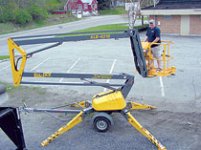SkunkWerX
Platinum Member
Have you ever seen how fast an FEL will fall if a hose bursts or a valve opens up? It's scary fast. It's deadly fast. As well, a full bucket can make a tractor very tippy, standing in the FEL puts the weight even higher up, increasing the machine's Center of gravity even more.
After 29 years in the telephone company, 25 of them in Outside Plant Operations, I can tell you that not adhering to safety while working aloft can injure or kill you whether on a ladder or in a man-rated bucket (truck). A majority of our accidents are in buckets, not on ladders.
Many people do not know how to use a ladder properly. I see ladders being used at angles so steep they will go over backwards if you sneeze, and so shallow they look more like a sagging bowed bridge than a ladder. On soggy and uneven ground too.
It only takes 5 minutes to tie off a ladder properly and securely to a tree or pole, and if done so correctly, will be as solid as the ground it is on.
There are other hazards such as electrical lines. Cut the limb, the limb contacts the power line, current flows down limb, into saw, through hands, out the feet, and down the aluminum ladder to ground. Congratualtions, you were a human fuse. You get the picture and it's not pretty.
ROPES. When cutting aloft and doing limbing operations you can use ropes to control how and where the limb will fall. You can even make 3/4 of your cut. Go back down to terra firma, and using proper precautions, pull the limb down with the rope. (Don't pull it down on top of you.) You can use ropes to secure your ladder, to secure your saw, and secure the tree you are cutting.
Bottom line, if you are reading this, you have the ability to check safety and working procedures for cutting trees , limbing (de-limbing) and working aloft.
10 or 15 minutes of reading can save your life. Best of all, it's free!!
Everyone, please be safe. Take a moment to step back, and look at each situation. Site assessment is the first key to a safe and smooth operation.
After 29 years in the telephone company, 25 of them in Outside Plant Operations, I can tell you that not adhering to safety while working aloft can injure or kill you whether on a ladder or in a man-rated bucket (truck). A majority of our accidents are in buckets, not on ladders.
Many people do not know how to use a ladder properly. I see ladders being used at angles so steep they will go over backwards if you sneeze, and so shallow they look more like a sagging bowed bridge than a ladder. On soggy and uneven ground too.
It only takes 5 minutes to tie off a ladder properly and securely to a tree or pole, and if done so correctly, will be as solid as the ground it is on.
There are other hazards such as electrical lines. Cut the limb, the limb contacts the power line, current flows down limb, into saw, through hands, out the feet, and down the aluminum ladder to ground. Congratualtions, you were a human fuse. You get the picture and it's not pretty.
ROPES. When cutting aloft and doing limbing operations you can use ropes to control how and where the limb will fall. You can even make 3/4 of your cut. Go back down to terra firma, and using proper precautions, pull the limb down with the rope. (Don't pull it down on top of you.) You can use ropes to secure your ladder, to secure your saw, and secure the tree you are cutting.
Bottom line, if you are reading this, you have the ability to check safety and working procedures for cutting trees , limbing (de-limbing) and working aloft.
10 or 15 minutes of reading can save your life. Best of all, it's free!!
Everyone, please be safe. Take a moment to step back, and look at each situation. Site assessment is the first key to a safe and smooth operation.

